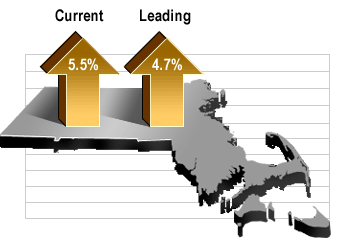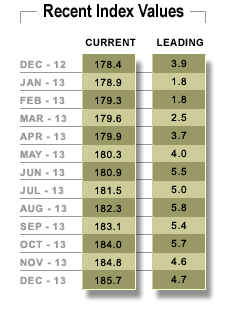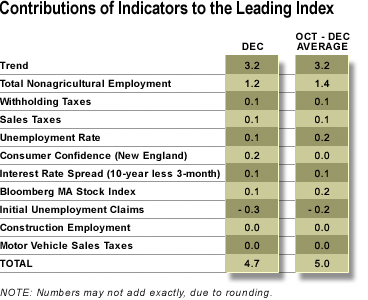State Economy Grows Robustly in Q4, UMass Journal Reports
Difficulties persist for the long-term unemployed, the young, and the undereducated
December 2013
 Massachusetts real gross domestic product grew at an estimated annual rate of 5.5 percent in the fourth quarter of 2013 according to the MassBenchmarks Current Economic Index, released today by MassBenchmarks, the journal of the Massachusetts economy published by the UMass Donahue Institute in collaboration with the Federal Reserve Bank of Boston. In contrast, according to the U.S. Department of Commerce, national real gross domestic product grew at an annual rate of 3.2 percent during the same period.
Massachusetts real gross domestic product grew at an estimated annual rate of 5.5 percent in the fourth quarter of 2013 according to the MassBenchmarks Current Economic Index, released today by MassBenchmarks, the journal of the Massachusetts economy published by the UMass Donahue Institute in collaboration with the Federal Reserve Bank of Boston. In contrast, according to the U.S. Department of Commerce, national real gross domestic product grew at an annual rate of 3.2 percent during the same period.
In 2013, state economic growth outpaced that of the nation in three of four quarters. In the first quarter, economic activity in Massachusetts grew at a 3.5 percent annual rate versus 1.1 percent for the U.S. In the second quarter, the Massachusetts economy expanded at a 1.9 percent annual as compared to 2.5 percent for the U.S. And in the third quarter, economic activity in Massachusetts grew at a revised 5.5 percent annual rate while the nation expanded at a 4.1 percent rate.
"The Massachusetts economy appears to be benefitting from improving conditions in national and international economies, and by increasingly confident households who are demonstrating a willingness to spend," noted Alan Clayton-Matthews, MassBenchmarks Senior Contributing Editor and Associate Professor of Economics and Public Policy at Northeastern University, who compiles and analyzes the Current and Leading Indexes.
 Merchandise exports ended the year (through November) up 4.3 percent after having fallen 7.7 percent in 2012. The recovery in export activity is due in part to improving conditions in Europe, which seems poised to grow in 2014. "Household balance sheets have strengthened considerably, fortified by four years of steady growth in employment and incomes, and more recent improvements in the stock market and home prices," noted Clayton-Matthews.
Merchandise exports ended the year (through November) up 4.3 percent after having fallen 7.7 percent in 2012. The recovery in export activity is due in part to improving conditions in Europe, which seems poised to grow in 2014. "Household balance sheets have strengthened considerably, fortified by four years of steady growth in employment and incomes, and more recent improvements in the stock market and home prices," noted Clayton-Matthews.
The pace of state growth in the fourth quarter was driven by strong employment growth, rising incomes, and improving consumer spending. In the fourth quarter, state employment grew at a 3.0 percent annual rate (representing almost 25,000 net new jobs) while wage and salary income in the Commonwealth — as estimated by withholding tax revenues — grew at a 12.3 percent annual rate. Spending on items subject to state regular and motor vehicle sales taxes rose at a 9.2 percent annual rate. Between the fourth quarters of 2012 and 2013, employment in Massachusetts grew by 1.6 percent, wages and salaries by 5.9 percent, and spending on taxable items by 6.9 percent.
However, the rising tide is not lifting all boats. Unemployment remains a big problem in Massachusetts and, at 7.0 percent the state's unemployment rate remains slightly higher than that of the nation. Conditions are particularly difficult for the long-term unemployed, the young, and the poorly educated. In 2013, the annual average unemployment rate (from the Massachusetts Current Population Survey) for persons under 25 years old was 15.8 percent. For those with less than a high school education it was 20.1 percent.
The MassBenchmarks Leading Economic Index for December is projecting a continuation of very solid growth in the first half of the year, predicting that real Massachusetts GDP will grow at a 5.0 percent annual rate in the first quarter and a 4.7 percent rate in the second.
 The 10 indicators that comprise the leading index usually do not all move in tandem. Typically, some may indicate an expectation of faster than average growth, while at the same time others may indicate an expectation of slower than average growth. The following table accounts for the contributions of each towards faster or slower growth than the long-term trend of 3.2 percent. The index value is their sum.
The 10 indicators that comprise the leading index usually do not all move in tandem. Typically, some may indicate an expectation of faster than average growth, while at the same time others may indicate an expectation of slower than average growth. The following table accounts for the contributions of each towards faster or slower growth than the long-term trend of 3.2 percent. The index value is their sum.
In December, seven indicators contributed to a forecast of above-trend growth: total nonagricultural employment, withholding taxes, sales taxes, the unemployment rate, consumer confidence, the interest rate spread between 10‑year and 3‑month U.S. Treasury securities, and the Bloomberg stock index for Massachusetts. One indicator, initial unemployment claims, contributed to below-trend growth. Two indicators contributed to average-trend growth: construction employment, and motor vehicle sales taxes.
In the three-month period October through December, six indicators contributed to a forecast of above-trend growth: total nonagricultural employment, withholding taxes, sales taxes, the unemployment rate, the interest rate spread between 10‑year and 3‑month U.S. Treasury securities, and the Bloomberg stock index for Massachusetts. One indicator, initial unemployment claims, contributed to below-trend growth. Three indicators contributed to average-trend growth: consumer confidence, construction employment, and motor vehicle sales taxes.
The current and historical quarterly estimates for state domestic product growth include adjustments for changes in productivity growth. These adjustments are estimates of the quarterly deviations from trend in the growth of the ratio of output to employment and output to wage and salary income. In the fourth quarter, these adjustments subtracted 0.2 percentage points from the annual rate of growth. In the third quarter, these adjustments added 1.2 percentage points to the annual rate of growth. In the second quarter, these adjustments subtracted 0.5 percentage points from the annual rate of growth. In the first quarter, these adjustments subtracted 0.2 percentage points from the annual rate of growth. For the forecast of state domestic product growth for the first and second quarters of this year, productivity growth is assumed to return to its long-term trend.
Several recent months of the indices are revised each release. These revisions are a result of the statistical method used to create the index, as well as revisions in the underlying indicators.
--------
All of the indicators except interest rates refer to Massachusetts. The current index is composed of four indicators: nonagricultural employment, withholding taxes, sales taxes, and the unemployment rate. The leading index includes these four current indicators plus the other six (leading) indicators in the contributions table. All of the indicators are as of December, except for interest rates and the Bloomberg stock index for Massachusetts, which are through January 24. The MassInsight Consumer Confidence Index is released every third month. Intervening months are interpolated, and changes in the Conference Board's Consumer Confidence Index for the U.S. are used to extrapolate to the current month of the index, as needed. Series measured in current dollars or values, i.e., withholding taxes, sales taxes, the Bloomberg stock index, and motor vehicle sales taxes, are deflated by the U.S. consumer price index for all urban consumers, excluding food and energy.
For a description of the methodology used to construct these indices, see: Alan Clayton-Matthews and James H. Stock, "An application of the Stock/Watson index methodology to the Massachusetts economy", Journal of Economic and Social Measurement, vol. 25 (1998/1999), pp. 183-233.
Dr. Alan Clayton-Matthews
MassBenchmarks
Northeastern University, School of Public Policy and Urban Affairs
January 30, 2014

